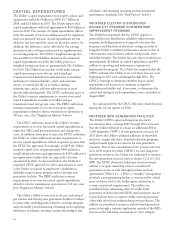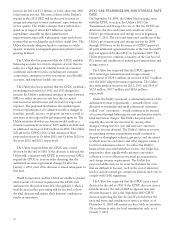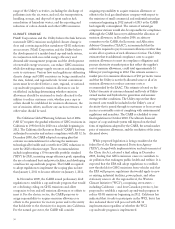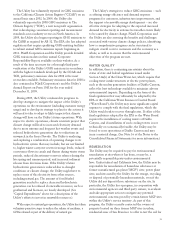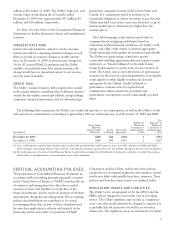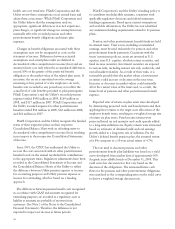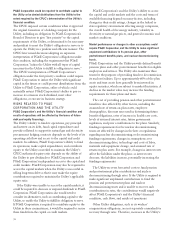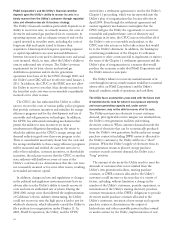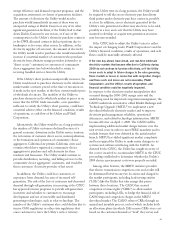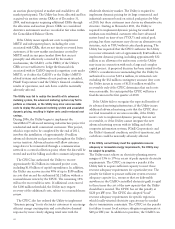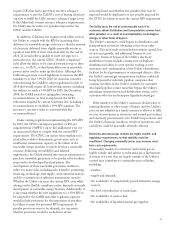PG&E 2009 Annual Report Download - page 39
Download and view the complete annual report
Please find page 39 of the 2009 PG&E annual report below. You can navigate through the pages in the report by either clicking on the pages listed below, or by using the keyword search tool below to find specific information within the annual report.the Utility records the liability based on its estimates of its
allocable share of the remediation liability. The recorded
liabilities are re-examined every quarter, and adjustments
are made based on changes in facts and circumstances or as
additional information becomes available.
At December 31, 2009 and 2008, the Utility’s accruals
for undiscounted and gross environmental liabilities were
$586 million and $568 million, respectively. The Utility’s
undiscounted future costs could increase to as much as $1
billion if other potentially responsible parties are not able
to contribute to these costs or if the extent of
contamination or necessary remediation is greater than
anticipated, and could increase further if the Utility
chooses to remediate beyond regulatory requirements.
Although the Utility has accrued for known environmental
obligations that are probable and reasonably estimable,
estimated costs may vary significantly from actual costs,
and the amount of additional future costs may be material
to results of operations in the period in which they are
recognized.
ASSET RETIREMENT OBLIGATIONS
The Utility accounts for an asset retirement obligation
(“ARO”) at fair value in the period during which the Utility
incurs the legal obligation if a reasonable estimate of fair
value and its settlement date can be made. A legal
obligation can arise from an existing or enacted law,
statute, or ordinance; a written or oral contract; or under
the legal doctrine of promissory estoppel.
At the time of recording an ARO, the associated asset
retirement costs are capitalized as part of the carrying amount
of the related long-lived asset. The Utility recognizes a
regulatory asset or liability for the timing differences between
the recognition of costs as recorded in accordance with GAAP
and costs recovered through the ratemaking process.
The fair value of an ARO is dependent upon the
following factors:
•Decommissioning costs: The estimated costs for labor,
equipment, material, and other disposal costs based on
the decommissioning studies;
•Inflation adjustment: The estimated cash flows are adjusted
for inflation estimates based on the component of cost;
•Discount rate: The fair value of the obligation is based on
a credit-adjusted risk-free rate that reflects the risk
associated with the obligation;
•Third-party mark-up adjustments: Internal labor costs
included in the cash flow calculation are adjusted for
costs that a third party would incur in performing the
tasks necessary to retire the asset; and
•Estimated date of decommissioning: The fair value of the
obligation will change based on the expected date of
decommissioning.
Changes in these factors could materially affect the
obligation recorded to reflect the ultimate cost associated
with retiring the assets. For example, a premature shutdown
of the nuclear facilities at Diablo Canyon would increase
the likelihood of an earlier start to decommissioning and
cause an increase in the obligation. (See Note 12 of the
Notes to the Consolidated Financial Statements.)
Additionally, if the inflation adjustment increased 25 basis
points, this would increase the amount of an ARO by
approximately 1.30%. Similarly, an increase in the discount
rate by 25 basis points would decrease the amount of an
ARO by 0.90%. At December 31, 2009, the Utility’s
estimated cost of retiring these assets is $1.6 billion.
ACCOUNTING FOR INCOME TAXES
PG&E Corporation’s and the Utility’s accounting for taxes
requires judgment regarding the potential tax effects of
ongoing operations and uncertain tax positions to
determine obligations owed to tax authorities. (See Note 9
of the Notes to the Consolidated Financial Statements.)
Amounts of deferred income tax assets and liabilities, as
well as current and noncurrent accruals, involve estimates
of the timing and probability of recognition of income and
deductions. Actual income taxes could vary from estimated
amounts due to the future impacts of various items,
including changes in tax laws, PG&E Corporation’s
financial condition in future periods, and the final review
of filed tax returns by taxing authorities.
PENSION AND OTHER POSTRETIREMENT
PLANS
Eligible employees and retirees of PG&E Corporation and
its subsidiaries receive qualified and non-qualified
non-contributory defined benefit pension plans. Retired
employees and their eligible dependents of PG&E
Corporation and its subsidiaries receive contributory
medical plans, and certain retired employees participate in
life insurance plans (referred to collectively as “other
postretirement benefits”). Amounts that PG&E
Corporation and the Utility recognize as costs and
obligations to provide pension benefits are based on a
variety of factors, including the provisions of the plans,
employee demographics and various actuarial calculations,
assumptions, and accounting mechanisms.
Actuarial assumptions used in determining pension
obligations include the discount rate, the average rate of
future compensation increases, and the expected return on
plan assets. Actuarial assumptions used in determining
other postretirement benefit obligations include the
discount rate, the expected return on plan assets, and the
35



